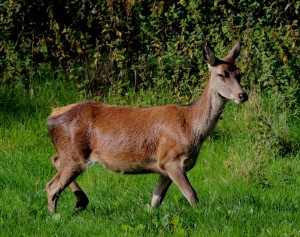 For most of the year the stags and hinds of red deer live apart and in some areas they are known as “hind forests” or “stag forests”. This comes from the old term “Deer Forests” when very large areas of the Highlands was covered with tracts of ancient woodland. Then the red deer, unlike today, was very much a woodland deer before extensive felling meant that they had to adapt more and more to the open hill. The annual cycle of the red deer evolves round three important stages which culminates in the next few weeks. For the hinds the early part of the year was critical as during late May or June they have their calves. With red deer hinds there is normally only one calf, in contrast to the roe deer does that often have twin kids, sometimes even triplets. Red deer will have their calves on traditional calving ground such as flats and terraces. The hind will seek out a quiet corner to drop her calf but then it becomes part of the social scene that can find hinds looking after each other’s calves. The fear is predation although nobody really knows how many calves are taken by predators such as the golden eagle and fox. Remains of calves found in golden eagle eyries, and for that matter sea eagles, plus fox dens may indicate dead calves found by the predator as opposed to live and healthy calves being predated.
For most of the year the stags and hinds of red deer live apart and in some areas they are known as “hind forests” or “stag forests”. This comes from the old term “Deer Forests” when very large areas of the Highlands was covered with tracts of ancient woodland. Then the red deer, unlike today, was very much a woodland deer before extensive felling meant that they had to adapt more and more to the open hill. The annual cycle of the red deer evolves round three important stages which culminates in the next few weeks. For the hinds the early part of the year was critical as during late May or June they have their calves. With red deer hinds there is normally only one calf, in contrast to the roe deer does that often have twin kids, sometimes even triplets. Red deer will have their calves on traditional calving ground such as flats and terraces. The hind will seek out a quiet corner to drop her calf but then it becomes part of the social scene that can find hinds looking after each other’s calves. The fear is predation although nobody really knows how many calves are taken by predators such as the golden eagle and fox. Remains of calves found in golden eagle eyries, and for that matter sea eagles, plus fox dens may indicate dead calves found by the predator as opposed to live and healthy calves being predated.
Meanwhile the red deer stags have their own problems, as in late February and March they cast their antlers. The timing depends on the size of the antlers and the condition of the stag. The different names for antlers are very traditional and rely mainly on the number of tines, referred to as points. If there are six points on both antlers and the top three form a cup then it is a “Royal”. In contrast a set of antlers with no points above the brow points is called a switch, whilst the stag with no antlers at all, not very common, is called a hummel. The problem the stags then faces is growing the antlers again to face the rut when the size of antlers and how the stags use them is all important. To this end stags will regularly chew antlers to seek out the calcium.
So the scene is set with the stags and hinds in good condition and the photograph I took of the red deer hind shows the animal in prime condition for the rut. There are probably more myths about the rut than any other part of the red deer’s life cycle. Most of the myths surround the so called master stag and is epitomised by the famous “Monarch of the Glen” painted by Edwin Landseer in 1851. The painting leaves the viewer with the idea that a stag is Lord of all he surveys. However, to start with a stag, even in its prime, will admittedly attract a number of hinds to form a harem. The stress of contesting other stags, even fighting, strutting around roaring, mating with the hinds and not having any time to eat takes its toll. Soon another stag will take its place and so the ritual starts again. Another myth is the fighting and we have been led astray by BBC Springwatch on the TV. In the rut stags do not spend all their time fighting as real fights with injury are very rare indeed. So now the rut is under way so why not get out in the glens and hills and listen to that roaring of the stags that epitomises the wildness of the Highlands?
Tags: highland wildlife
